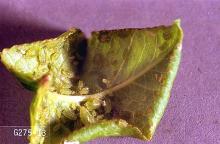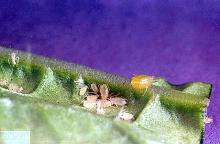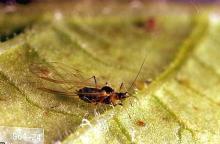Includes
Bean aphid (Aphis fabae)
Green peach aphid (Myzus persicae)
Willow-carrot aphid (Cavariella aegopodii)
Pest description and crop damage The willow-carrot aphid is green to greenish yellow. Its primary host is willow, but it feeds on carrot during the summer. The green peach aphid is slender, dark green to yellow, and has no waxy bloom. Green peach aphid infestations may result in wilting. The bean aphid is dark olive green to black with light-color legs. It is usually more of an early-year pest.
Biology and life history
See:
Common Pests of Vegetable Crops
Pest monitoring Check fields frequently after seedling emergence. If aphids become numerous, increase frequency of sampling. Aphids often are concentrated in hot spots or near the field margin. Note the presence of any hot spots but avoid sampling only those areas. Also, be sure to look for evidence of biological control, i.e., the presence of predators, parasitoids (aphid mummies), and pathogens. Aphid flights are most common during periods of moderate temperatures (60° to 80°F). Monitor fields particularly closely during April and May.
Management-biological control
Many parasitoids and predators attack aphids. Early year aphids have many natural enemies that frequently bring them under control later in the year. Among the more common predators are lady beetles and their larvae, lacewing larvae, and syrphid fly larvae. Populations of green peach aphids are reduced in winter by the insect pathogenic fungus Entomophthora aphidis.
Monitor the proportion of aphid mummies relative to unparasitized aphids and the numbers of predators such as lady beetles. If the proportion of mummies is increasing, or predators appear to be gaining control, and aphid populations are not yet damaging, avoid sprays that will disrupt these natural enemies. Most materials available for aphid control are highly disruptive of natural enemy populations.
Management-cultural control
Destroy infested crops immediately after harvest to prevent dispersal. Destroying weed hosts late in the year may help destroy overwintering populations. Aphid populations tend to be higher in crops that are fertilized liberally with nitrogen. Roguing diseased plants early may help slow the spread of aphid-vectored diseases. Home gardeners can often get effective control by washing aphids with a strong stream of water.
Management-chemical control: HOME USE
Apply to both tops and undersides of leaves.
- acetamiprid
- azadirachtin (neem extract)-Some formulations are OMRI-listed for organic use.
- capsaicin-Some formulations are OMRI-listed for organic use.
- carbaryl
- cyfluthrin
- imidacloprid
- insecticidal soap-May require several applications. Some formulations are OMRI-listed for organic use.
- kaolin-Applied as a spray to foliage It acts as a repellent to some insect pests. Some formulations are OMRI-listed for organic use. Not registered for use in OR.
- malathion
- permethrin
- plant-derived essential oils (rosemary, peppermint etc.)-Have some efficacy against aphids. Some formulations are OMRI-listed for organic use.
- pyrethrins-Some formulations are OMRI-listed for organic use.
- zeta-cypermethrin
Management-chemical control: COMMERCIAL USE
- acephate (Acephate 90 WDG) at 0.5 to 1.0 lb ai/A. PHI 21 days. REI 24 hr. Retreatment interval 7 days. Trim tops. Do not use tops for food or feed. All celery must be trimmed before shipment for use. Do not exceed 2 lb ai/A per year.
- acetamiprid (Assail 30SG) at 0.038 to 0.075 lb ai/A. PHI 7 days. REI 12 hr. Retreatment interval 7 days. Do not exceed 0.375 lb ai/A or five applications per season.
- alpha-cypermethrin (Fastac EC) at 0.014 to 0.025 lb ai/A. PHI 1 day. REI 12 hr. Retreatment interval 7 days. Do not exceed 0.075 lb ai/A per season.
- Beauveria bassiana (Mycotrol ESO) at 0.25 to 1 quart/A. PHI 0 days. REI 4 hr. OMRI-listed for organic use.
- beta-cyfluthrin (Baythroid XL, Tombstone) at 0.019 to 0.022 lb ai/A. PHI 7 days. REI 12 hr. Retreatment interval 14 days. Do not exceed 0.05 lb ai/A per season. Avoid use when bees are foraging.
- bifenthrin (Brigade WSB) at 0.033 to 0.1 lb ai/A. PHI 7 days. REI 12 hr. Do not exceed 0.5 lb ai/A per season. Retreatment interval 7 days.
- Burkholderia spp. (Venerate XC) at 2 to 4 quarts/A product. PHI 0 days. REI 4 hr. OMRI-listed for organic use.
- Chromobacterium subtsugae (Grandevo) at 0.6 to 0.9 lb ai/A per 100 gal. PHI 0 days. REI 4 hr. OMRI-listed for organic use.
- cyantraniliprole (Exirel) at 0.088 to 0.133 lb ai/A. PHI 1 day. REI 12 hr. Retreatment interval 5 days. Limit 6 treatments per year. Do not exceed 0.4 lb ai/A per year. An adjuvant will improve efficacy.
- flonicamid (Beleaf 50SG) at 0.062 to 0.089 lb ai/A. PHI 0 days. REI 12 hr. Do not exceed 0.267 lb ai/A or three applications per season. Retreatment interval 7 days.
- flupryadifurone (Sivanto 200SL) at 0.14 to 0.16 lb ai/A. PHI 1 day. REI 4 hr. Limit 3 treatments per season. Retreatment interval 7 days. Do not exceed 0.365 lb ai/A per season.
- imidacloprid (Admire Pro) at 0.158 to 0.38 lb ai/A. Soil application only. PHI 45 days. REI 12 hr. Do not exceed 0.38 lb ai/A per season.
- insecticidal soap (M-Pede) at 1 to 2% solution. Potassium salts of fatty acids. See label for gal/A. PHI 0 days. REI 12 hr.
- pymetrozine (Fulfill) at 0.086 lb ai/A. A penetrating adjuvant improves performance. PHI 7 days. REI 12 hr. Do not exceed 0.17 lb ai/A per season. Retreatment interval 7 days. Not registered for use in OR.
- spirotetramat (Movento) at 0.06 to 0.08 lb ai/A. PHI 3 days. REI 24 hr. Retreatment interval 7 days. Do not exceed 0.16 lb ai/A per season.
- thiamethoxam (Actara) at 0.023 to 0.047 lb ai/A. PHI 7 days. REI 12 hr. Retreatment interval 7 days. Do not exceed 0.172 lb ai/A per season.
- thiamethoxam (Platinum) at 0.078 to 0.172 lb ai/A. Soil application only. PHI 30 days. REI 12 hr. Do not exceed 0.172 lb ai/A per season.
- tolfenpyrad (Torac) at 0.17 to 0.21 lb ai/A PHI 1 day. REI 12 hr. Limit 4 applications per year; 2 per crop cycle. Retreatment interval 14 days. Do not exceed 0.42 lb ai/A per year.
- zeta-cypermethrin (Mustang) at 0.028 to 0.05 lb ai/A. PHI 1 day. REI 12 hr. Do not exceed 0.3 lb ai/A per season. Retreatment interval 7 days.






